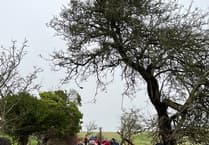SOUTH West Water has said it is “serious about tackling storm overflows” – but local councillors have described levels of spillage into the River Tamar as “alarming and unacceptable”.
Environment Agency data shows that in 2023 the 13 combined sewer overflows in Chilsworthy, Calstock, Gunnislake, Harrowbarrow and Metherell released 11,380 hours of sewage into the Tamar on over 1,073 occasions.
“That is an increase of 39 per cent above the previous year’s levels, which were already very alarming,” said Councillor Alastair Tinto, Calstock ward member of Calstock Parish Council.
The worst discharges in Calstock Parish were from the Metherell Waste Water Treatment Works which spilled over 3,500 hours of sewage across 181 events.
Parish councillor for Harrowbarrow Andrew Brown said: “This is quite unacceptable. For the third year in a row Metherell has discharged over 25 per cent of the muck in the parish. Last year we called on South West Water to do something but nothing has happened. It can’t be allowed to continue like this.”
While there has been a significant reduction in spills at the Chilsworthy works, the picture has worsened in Gunnislake and Calstock.
Combined sewer overflows allow sewage and rainwater to be diverted into the river at times of heavy rainfall to stop the sewage treatment works from being overwhelmed. South West Water says that the increase in spills is because of the number of storms and extremely heavy rain in 2023.
“It’s clear we need to redesign our systems, which we are already doing, investing £850m over two years.”
It says that another reason the number of spills appears so high is because it records data at a “much more granular level” than other companies: “We record at two minute intervals. For example, a spill of four minutes total duration within a single 15 minute period is recorded. This is not necessarily the case for all companies where reporting on a 15 minute interval basis (as per the regulatory guidance) would not have recorded a spill of any duration.”
SWW says it monitors exactly “when and where” each spill happens, allowing it to target investment to the worst areas. Calstock councillors want to see this information made public.




